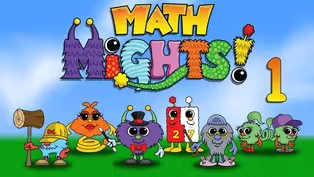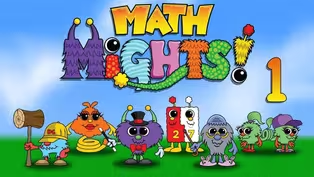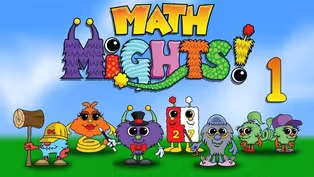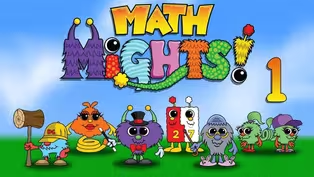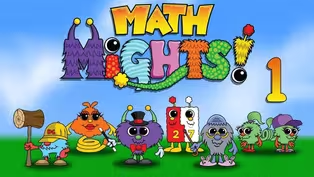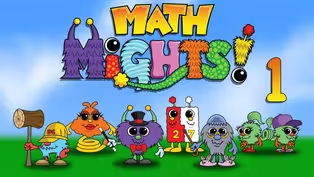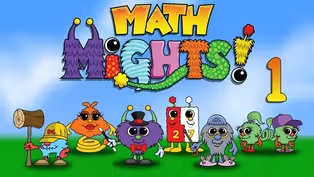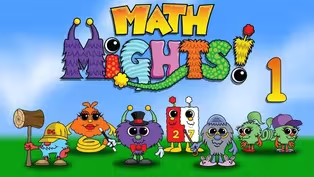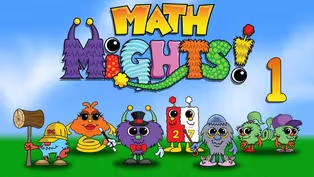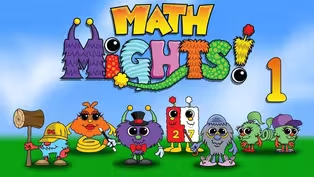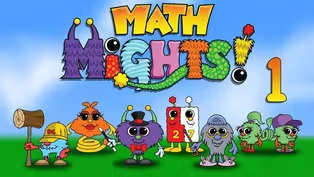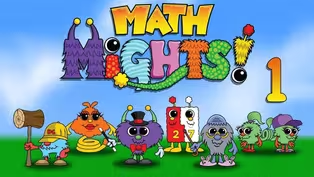Math Mights
Adding Tens-Tens and Ones-Ones
Season 3 Episode 310 | 15m 35sVideo has Closed Captions
Join Mrs. Markavich for a missing addend word problem with Professor Barble!
Join Mrs. Markavich for a missing addend word problem with Professor Barble! Next we are going to spend some quality time with Value Pak as we learn to add by adding tens and tens then ones and ones!
Problems playing video? | Closed Captioning Feedback
Problems playing video? | Closed Captioning Feedback
Math Mights is a local public television program presented by Detroit PBS
Math Mights
Adding Tens-Tens and Ones-Ones
Season 3 Episode 310 | 15m 35sVideo has Closed Captions
Join Mrs. Markavich for a missing addend word problem with Professor Barble! Next we are going to spend some quality time with Value Pak as we learn to add by adding tens and tens then ones and ones!
Problems playing video? | Closed Captioning Feedback
How to Watch Math Mights
Math Mights is available to stream on pbs.org and the free PBS App, available on iPhone, Apple TV, Android TV, Android smartphones, Amazon Fire TV, Amazon Fire Tablet, Roku, Samsung Smart TV, and Vizio.
Providing Support for PBS.org
Learn Moreabout PBS online sponsorshipMore from This Collection
Video has Closed Captions
Join Mrs. Markavich for a missing addend word problem with Professor Barble! (16m 5s)
Write Equations to Match the Strategy
Video has Closed Captions
Join Mrs. Markavich for a missing addend word problem with Professor Barble. (16m 2s)
Video has Closed Captions
Join Mrs. Markavich for a subtraction word problem with Professor Barble. (15m 59s)
Video has Closed Captions
Join Mrs. Markavich for a missing addend word problem. (16m 6s)
Add 2-Digit Numbers & Write Equations
Video has Closed Captions
Join Mrs. Markavich for a word problem with her friend Professor Barble! (15m 59s)
Comparing Numbers Different Ways
Video has Closed Captions
Value Pak shows you the different ways to compare 2-digit numbers. (15m 44s)
Video has Closed Captions
Join Mrs. Markavich for a word problem with her friend Professor Barble! (15m 59s)
Video has Closed Captions
Join Mrs. Markavich for a word problem with her friend Professor Barble! (15m 59s)
Decompose/Compose #'s Different Ways
Video has Closed Captions
We show you different ways to decompose and compose 2-digit numbers! (15m 59s)
Video has Closed Captions
Join Mrs. Markavich & Dotson to talk about numbers with the Counting Buddy Senior! (16m)
Video has Closed Captions
Join Mrs. Markavich & Dotson for a Numeracy Talk with the Counting Buddy Senior (16m)
Video has Closed Captions
Join Mrs. Markavich for Numeracy Talk with Dotson working on conservation to 20. (16m)
Providing Support for PBS.org
Learn Moreabout PBS online sponsorship(upbeat music) - [Children] Math mights!
- Welcome, first grade math mights, I'm Mrs. Markavich, and I'm so excited you're here with me today.
Let's check out our plan for the day.
Today we'll be solving a word problem with my friend, Professor Barble, and then we'll be adding tens and tens and ones and ones.
Let's warm up our math brain with my friend, Professor Barble, as he conquers word problems.
Hey, Professor Barble.
Professor Barble is a math might that lives in Mathville, and he loves to solve word problems.
And if he slows down to think about what the question is really asking, and he presses on his thinking cap, a really cool tool will come out to help him create a picture of what the problem is asking him to solve.
You might ask yourself, what is a visual model?
A visual model is sometimes known as a model drawing, unit bar, tape diagram or bar model.
Drawing a visual model helps to visualize the strategies and understand what the word problem is asking.
A visual model is also a reading comprehension strategy for a word problem.
In first grade, we use a template that looks like this.
Let's read our problem.
Our problem says 10 snowflakes fell on Sam's mitten, and six fell on his coat.
Nine of the snowflakes on Sam's mitten melted.
How many snowflakes are left?
My friend Jose says, "I think maybe we should add to solve this problem," but Luke says "Or wait, do we subtract?"
Professor Barble says, "Hold on a minute, "let's slow down."
Professor Barble doesn't want us to guess, do I add or do I subtract?
He wants us to use a step-by-step visual model process to create a picture in our mind of what the problem is asking us.
Let's get started with our first step.
In step number one, we're going to read the problem and put in some chunks so that we can gather the information.
I'm going to read it and then you're going to echo back, and we'll put the chunks in together.
Let's give it a try.
10 snowflakes fell on Sam's mitten, chunk, and six fell on his coat, chunk.
Nine of the snowflakes on Sam's mitten melted, chunk.
How many snowflakes are left, chunk.
Step number two, we're going to rewrite the question in the sentence form with a blank space for the answer.
We do this so we know what the problem is asking us to solve for.
Eventually, you'll be writing this on your own.
We're helping you now, but as you get better, you'll be able to do it, I know it.
Step number three is to determine the who or the what is involved in our problem.
If you look at mine, you can see the who or the what are snowflakes.
Then our next step, step four is to draw the unit bar.
When you look at mine, you can see that it's a two-step problem, so I have made two unit bars for us.
We'll add in the sections together later.
Step number five is when we check when each of our chunks have been added to our unit bar, let's do that together.
It says, 10 snowflakes fell on Sam's mitten.
I'm going to divide my unit bar like this, and I'm going to put a 10 here, and I'm going to label it an m for mitten.
Then I'm going to go up and check it off.
The next part says, and six fell on his coat.
So I'm going to put six on this side and label it with a C for coat.
And I'm going to go back up here and check that off.
The next part says nine of the snowflakes on Sam's mitten melted.
Now I need to go down to my second unit bar.
Before I add the nine, I need to put that section in, and we know that nine is a little smaller than 10, so I'm gonna make my line a little bit further over.
They're not going to line up.
I'm going to put in a nine and remember, these were on his mitten, and because they melted, I'm going to cross it off.
Then I have to go back up here and check that I added it to my unit bar.
The next part says, how many snowflakes are left?
Here is where I'm going to put in l for left.
This is the part that I don't know.
So I have to add my question mark.
I'm going to put a question mark here and I'm going to check it off.
One more thing that I need to do is I'm going to eventually need to know the total here.
I'm going to put a box here with a purple marker, and put a question mark in that box.
That same total is going to be the same down here.
I'm gonna put a little line so that you know these two will be exactly the same.
My next step is for me to compute and solve the problem.
My friend says, "Oh, now I see what we need to do "to solve this problem."
Let's solve it together.
I can see that in the top for step number one, the first thing I need to do is solve 10 and six to get the whole number.
I'm going to add that down here, 10 plus six equals 16.
Then on the bottom, part is missing.
That tells me I'm going to have to subtract.
So I need to start with a whole number, 16.
16 minus the part that I crossed off, nine, gives me an answer of seven.
Wow, that sure was a lot of steps, but don't forget, I have one more really important step, step number seven.
I have to write the answer up in my sentence and check.
So I'm gonna go back up to the sentence that I wrote in step two.
There are, left.
My answer and my missing part was seven.
And what was it that we needed to fill in there?
Oh, that's right, my who or what was snow flakes.
So I know there are seven snowflakes left.
Boys and girls, Professor Barble would be really proud of us using the step-by-step visual model process to solve this word problem.
I think it's time for us to take a look at our I can statement of the day.
It says, I can add two digit numbers by adding tens and tens and ones and ones.
Jose added this problem and showed this for his work.
The problem is 37 plus 26.
When I look at his work, you can see that he put it into two groups.
He has a group on this side that has some tens, and he has a group on this side that has some ones.
I think maybe he used our friend Value Pak.
Let's call on him to help us out.
Hey, Value Pak.
If you remember, our friend Value Pak comes from a family that wears their value on their bellies.
They can work like a family all together when they are clipped together, or they could work on their own because they each hold their own value and click apart to work by themselves.
What did Jose add to his drawing to make it clear how he added, 37 plus 26?
Luke says, "Jose added the tens and the tens "and the ones and the ones like Value Pak!
"He added the 30 and the 20 to get 50, "and added the six and the seven to get 13."
It looks like he may have added a 10 with the five and the five, and then added 10 plus three equals 13.
Wow, that was a lot that Luke had to share with us.
I think we need to take a closer look at it.
I have the problem, 37 plus 26.
You can see at the top, I have 10, 20, 30, 31, 32, 33, 34, 35, 36, 37.
At the bottom, I have 26.
10, 20, 21, 22, 23, 24, 25, 26.
And my friend Jose organized the tens on this side and the ones on this side.
We have 10, 20, 30, 40, 50, five tens makes 50.
And on this side, we have the ones, but what you can see is that I can actually make another 10 right here.
One, two, three, four, five, six, seven, eight, nine, 10, and then one, two, three, give us 13.
And I know that 50 add 13 gives me the answer of 63.
That was really great thinking, Jose.
And thanks Luke for that awesome description.
I think our friend, Value Pak got a little bit lazy, and he needs us to help him finish the work with this problem.
The problem is 28 plus 56.
He started to solve it for us, but then he forgot to finish.
Let's take a look at it.
This is how he started.
I think we need to act this out together on my whiteboard.
Let's head over and take a look.
You can see that we have 28 plus 56.
We used Value Pak to help us with 20 and eight and 50 and six.
It looks like Value Pak added the 20 and the 50 to get a 70, but that's where he got lazy.
He forgot to add the eight and the six or our ones.
So let's do that now.
Let's add eight and six.
And when I do that, I get 14.
And my last step is to add all of our tens and ones together.
And that will look like this.
70 plus 14 equals 84.
Thanks so much for helping Value Pak solve this.
But I think he has another one where he gets a little lazy again.
This time, our problem says 27 plus 44.
Once again, my friend Value Pak gets started but he gets lazy.
He starts with this.
He starts by adding only our ones.
We need to check this out and act it out on my whiteboard.
When we look over here, we can see that he added the seven and the four first.
He added our ones to get 11, but he got lazy and he forgot to add our tens, 20 and 40.
I'm gonna do that for you.
I know that 20 and 40 give me 60.
Now, our last step is just to finish that work, 60 plus 11 equals 71.
Thanks for helping Value Pak finish this problem, he really needed our help today.
This time my friend, Value Pak says, "I want you to try it on your own."
So let's head over and take a look at this problem, 34 plus 57.
I'm going to decompose my 34 and get 30 and four.
Then I'm going to decompose the 57 and get 50 and seven.
Now, I get to decide if I want to add the tens and the tens first or the ones and the ones first.
So I think I'm gonna start by adding my tens and my tens first, that always seems a little bit easier.
If I add 30 and 50, I'll get the number 80.
Then I can add my ones, four and seven to get the number 11.
My last step is to put it all together.
80 plus 11 equals 91.
That went really smoothly, and I think that I have a good understanding of how to add tens and tens and ones and ones.
Value Pak thinks we're getting so good at this, we should try it one more time.
Here's another problem, 18 plus 55.
When we look at it on mine, you can see that I have 18 plus 55.
I'm going to decompose the 18 to get 10 and eight.
Then I'm going to decompose the 55 to get 50 and five.
This time I'm going to start with the ones.
I'm going to add the eight and the five, which will give me 13.
Then my next step is to add the tens.
I'm going to add 10 and 50, which will give me the answer of 60.
And my very last step is to add 60 plus 13.
And I know that 60 plus 13 is 73.
You're doing such an amazing job at this that I have one more challenge for you.
Luke solved a problem, and he wants to know if you can guess what problem he was solving.
Let's work this backwards.
I can see that I have 80 plus 11 equals 91.
If I look at the 80 first, you can see that 30 and 50 equal 80, and you can see that four and seven equal 11.
If I move to the next step, if I take that four and hide that zero, that gives me the number 34.
Then if I look over here and I see the 50 and the seven, I can take the seven and hide that zero to get the number 57.
So I think that the original problem that he started with was 34 plus 57 equals 91.
Wow, that was a lot of work and great thinking, Luke.
It's your turn to add two digit numbers with Value Pak.
I think you'll have fun doing this with a friend.
I had so much fun with you today, friends, thanks so much.
Until next time, kiss your brains.
(upbeat music) - [Narrator] Sis4teachers.org.
Changing the way you think about math.
- [Narrator] This program is made possible with funding from the Michigan Department of Education, Governor's Education Emergency Funds, the state of Michigan, and by viewers like you.
(upbeat music)


- Home and How To

Hit the road in a classic car for a tour through Great Britain with two antiques experts.










Careers that Work

Support for PBS provided by:
Math Mights is a local public television program presented by Detroit PBS
